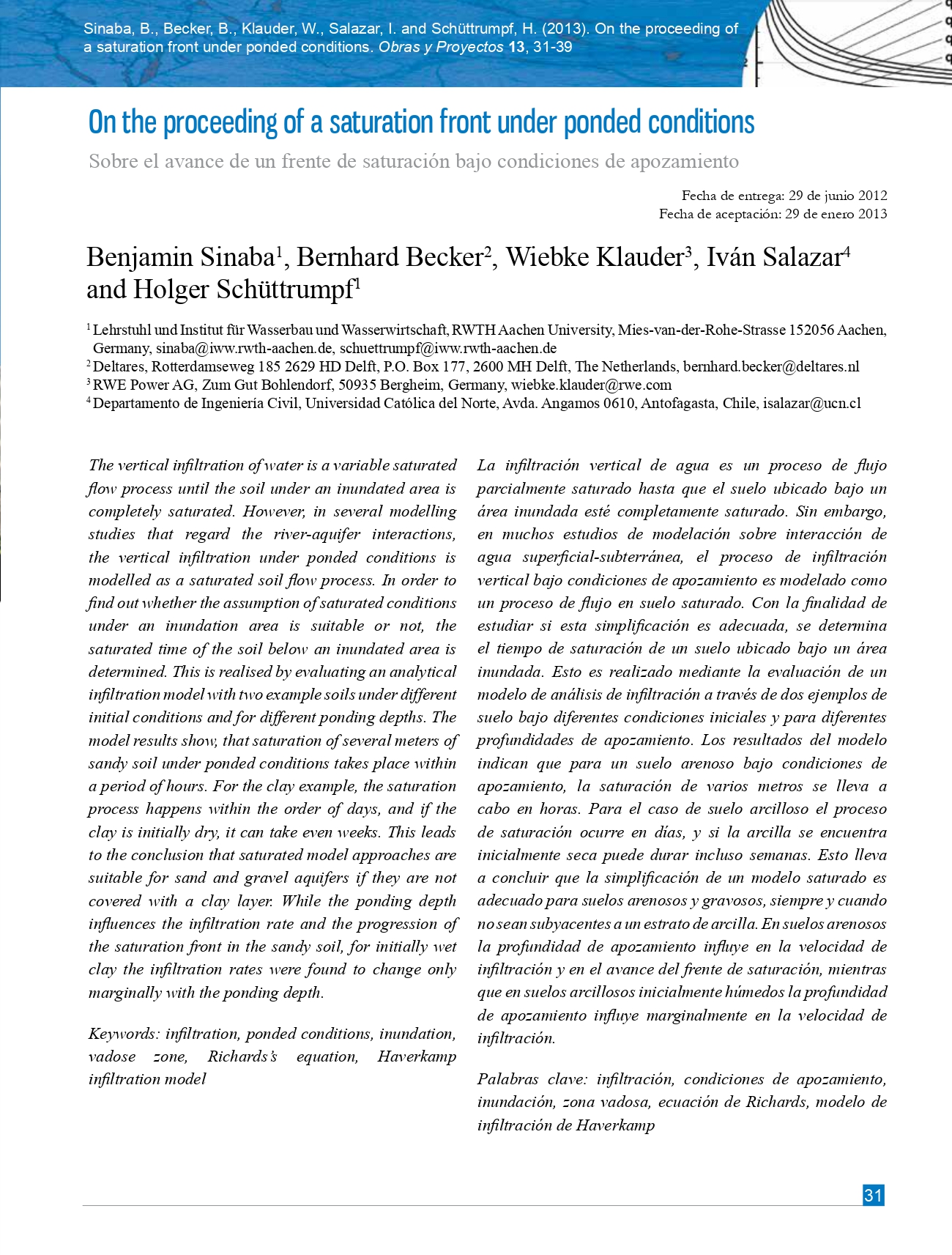On the proceeding of a saturation front under ponded conditions
DOI:
https://doi.org/10.4067/S0718-28132013000100003Keywords:
infiltration, ponded conditions, inundation, vadose zone, Richards's equation, Haverkamp infiltration modelAbstract
The vertical infiltration of water is a variable saturated flow process until the soil under an inundated area is completely saturated. However, in several modelling studies that regard the river-aquifer interactions, the vertical infiltration under ponded conditions is modelled as a saturated soil flow process. In order to find out whether the assumption of saturated conditions under an inundation area is suitable or not, the saturated time of the soil below an inundated area is determined. This is realised by evaluating an analytical infiltration model with two example soils under different initial conditions and for different ponding depths. The model results show, that saturation of several meters of sandy soil under ponded conditions takes place within a period of hours. For the clay example, the saturation process happens within the order of days, and if the clay is initially dry, it can take even weeks. This leads to the conclusion that saturated model approaches are suitable for sand and gravel aquifers if they are not covered with a clay layer. While the ponding depth influences the infiltration rate and the progression of the saturation front in the sandy soil, for initially wet clay the infiltration rates were found to change only marginally with the ponding depth.
References
Barry, D.A., Parlange, J.Y., Haverkamp, R. and Ross, P.J. (1995). Infiltration under ponded conditions: 4. An explicit predictive infiltration formula. Soil Science 160(1): 8-7.
Bauer, P., Gumbricht, T. and Kinzelbach, W. (2006). A regional coupled surface water/groundwater model of the Okavango Delta, Botswana. Water Resources Research 42, No. W04403. https://doi.org/10.1029/2005WR004234
Becker, B.P.J. (2010). Zur gekoppelten numerischen Modellierung von unterirdischem Hochwasser. Dissertation RWTH Aachen University
Becker, B.P.J., Forberig, S., Flogel, R., Schüttrumpf, H. and Kongeter, J. (2012). On the determination of groundwater levels for hazard maps of groundwater head rise induced by high water. Wasser Wirtschaft 12, 10-16
Beven, K. and Germann, P. (1982). Macropore and water flow in soils. Water Resources Research 18 (5): 1311-1325. https://doi.org/10.1029/WR018i005p01311
Chong, S.K. and Green, R.E. (1983). Sorptivity measurement and its application. In: Proceedings of the National Conference on Advances in Infiltration, American Society of Agricultural Engineers, 12-13 Dec. 1983, Chicago, Illinois, 82-91.
Freeze, R. A. (1972). Role of Subsurface Flow in Generating Surface Runoff. 1. Base Flow Contributions to Channel Flow. Water Resources Research 8, No. 3, 609-623. https://doi.org/10.1029/WR008i003p00609
Freeze, R.A. and Cherry, J.A. (1979). Groundwater. Prentice Hall, Englewood Cliffs, New Jersey.
Gillham, R.W. (1984). The capillary fringe and its effect on water table response. Journal of Hydrology 67, 307-324. https://doi.org/10.1016/0022-1694(84)90248-8
Green, W.H. and Ampt, G.A. (1911). Studies on Soil Physics: 1. Flow of Air and Water through Soils. The Journal of Agricultural Science 4, 1-4. https://doi.org/10.1017/S0021859600001441
Haverkamp, R., Parlange, J.Y., Starr, J.L., Schmitz, G. and Fuentes, C. (1990). Infiltration under ponded conditions: 3. A predictive equation based on physical parameters. Soil Science 149, No. 5, 292-300.
Homann, C. (2006). Automatische Optimierung von Grundwasserhaltungen in von Hochwasser beeinflussten Aquiferen. Dissertation RWTH Aachen University.
Huber, G., Hiller, G. and Braune, A. (2003). Konzepte des Hochwasserschutzes für die Bauten des Freistaates Sachsen im Historischen Stadtkern von Dresden. In: Umweltamt Landeshauptstadt Dresden and Dresdner Grundwasserforschungszentrum e.V. (eds.), Hochwassernachsorge Grundwasser Dresden, Wissenschaftliche Tagung zum BMBF-Forschungsprojekt/8.Oktober 2003/ Dresden, Rathaus/Tagungsband. Dresden Druckerei und Verlag Christoph Hille, 57-62.
Koch, A., Meon, G. and Leibundgut, C. (2007). Die gekoppelte Simulation der 2D-Oberflachenwasser- und 3D-Grundwasserstr0mung im Rahmen eines Expertensystems zur Modellierung der hydrodynamischen Wechselwirkungen einer Flusslandschaft. In: Meon, G., Sauter, Führbôter and Wolf (eds.): Niedersachsisches Grundwasserkolloquium 21.-22. Februar 2007 in Braunschweig. Grundwasser, Hochwasser und Salzwasser/Konzepte zur Risikominimierung. Stuttgart: E. Schweizerbart'sche Verlagsbuchhandlung (Nägele u. Obermiller), Zentralblatt für Geologie und Paläontologie/Teil I Allgemeine, Angewandte, Regionale und Historische Geologie Vol. 2007, No. 1/2, 99-114.
Kolymbas, D. (1998). Geotechnik: Bodenmechanik und Grundbau. Springer, Berlin.
Kreibich, H. and Thieken, A.H. (2008). Assessment of damage caused by high groundwater inundation. Water Resources Research 44, No. 9. http://doi.org/10.1029/2007WR006621.
Monninkhoff, B. and Kernbach, K. (2006). Coupled surface water - groundwater modeling for planning of flood retention in the Lower Havel area. In: Proceedings of the: International FEFLOW User Conference, September 10-15, 2006 Berlin, Germany, 115-124.
Peetz, J.-V. and Steckel, B. (2007). 3-code coupling in flood simulation. In: MpCCI 8th user forum proceedings, february 13 and 14, 2007, 108-116. http://www.mpcci.de/fileadmin/mpcci/Userforum/MpCCI_8th_UserForum.pdf
Philip, J.R. (1957). Theory of infiltration: 1. The infiltration equation and its solution. Soil Science 83(5), 345-358.
Philip, J.R. (1969). Theory of infiltration. Advances in Hydroscience 5, Academic Press, 215-296.
Rawls, J.W. and Brakensiek, D.L. (1983). A procedure to predict Green and Ampt infiltration parameters. In: Proceedings of the National Conference on Advances in Infiltration, American Society of Agricultural Engineers: 12.-13. Dec. 1983, Chicago, Illinois, 102-112.
Salazar, I. (2011). Beitrag zur Verringerung der Schadstoffkonzentration in heterogenen porosen Medien. Dissertation RWTH Aachen University.
Schaap, G. M. (2009). Rosetta: A computer program for estimating soil hydraulic parameters with hierarchical pedotransfer functions. url: http://ag.arizona.edu/research/rosetta/download/rosetta.pdf, checked 2009-12-10.
Schaap, M.G. and van Genuchten, M.T. (2006). A modified Mualem-van Genuchten formulation for improved description of the hydraulic conductivity near saturation. Vadose Zone Journal 5, No. 1, 27-34. https://doi.org/10.2136/vzj2005.0005
Schmitz, G., Haverkamp, R., Parlange, J.Y. and Liedl, R. (1989). Infiltration bei eingestauter Bodenoberflaeche. 1. Analytische Lôsung der Infiltrationsgleichung und praktische Berechnung der Versickerung. Zeitschriftfür Kulturtechnik und Landentwicklung 30, No. 2, 121-131.
Sinaba, B. (2007). Zur Infiltration bei eingestauter Bodenoberflache. Diplomarbeit RWTH Aachen University SLUG Sächsisches Landesamt für Umwelt und Geologie (2003). Einfluss des August Hochwassers 2002 auf das Grundwasser. Materialien zur Wasserwirtschaft.
Sommer, T. and Ullrich, K. (2004). Das unsichtbare Hochwasser - Auswirkungen des August-Hochwassers 2002 auf das Grundwasser im Stadtgebiet von Dresden. In: 34. IWASA Internationales Wasserbau-Symposium Aachen 2004 : Hochwasserschutz - eindeichen oder ausweichen. Mitteilungen des Inst. f. Wasserbau und Wasserwirtschaft, RWTH Aachen. Aachen: Shaker, 203-224.
Sommer, T. and Eulitz, K. (2007). Auswirkungen des Hochwassers auf das Grundwasser/Phänomene und Modellansätze. In: Meon, Sauter, Führbôter and Wolf (eds.): Niedersachsisches Grundwasserkolloquium 21.-22. Februar 2007 in Braunschweig: Grundwasser, Hochwasser und Salzwasser/Konzepte zur Risikominimierung. Stuttgart: E. Schweizerbart'sche Verlagsbuchhandlung (Nägele u. Obermiller), Zentralblatt für Geologie und Paläontologie/Teil I Allgemeine, Angewandte, Regionale und Historische Geologie Vol. 2007, No. 1/2, 7-15.
van Linn, A. (2006). Automatische Optimierung zur Bewertung USDA United States Department of Agriculture (2009). USDA Risikoanalyse einer Hochwasserschutzma fi nahme. Dissertation RWTH Aachen University. Textural Classification Chart. url: http://www.gintsoftware.com/Jdownloads/reports/usda_textural_class.pdf, checked 2009-12-10.
van Genuchten, R. (1978). Calculating the unsaturated hydraulic conductivity with a new closed-form analytical model. Water Resources Program: Department of Civil Engineering, Princeton University.

Downloads
Published
Issue
Section
License
Copyright (c) 2013 Universidad Católica de la Santísima Concepción

This work is licensed under a Creative Commons Attribution-NonCommercial 4.0 International License.







